Union Pacific Bundle
How does Union Pacific dominate the freight transportation landscape?
Union Pacific, a cornerstone of American logistics since 1862, has evolved its sales and marketing to stay ahead. From its roots connecting a nation via the transcontinental railroad, the company now employs cutting-edge strategies to deliver freight solutions. This deep dive explores the Union Pacific SWOT Analysis, revealing how the company navigates a competitive market.
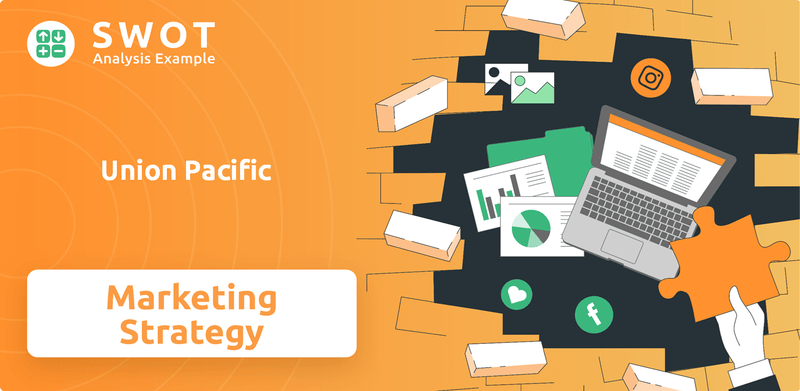
Understanding the intricacies of the Union Pacific sales strategy and Union Pacific marketing strategy is crucial for anyone interested in the railroad marketing and rail freight sales sectors. This analysis of UP sales and marketing will cover everything from the company's target market and brand positioning strategy to its digital marketing strategy and customer relationship management. We will also look at Union Pacific's sales performance analysis and sales growth strategies.
How Does Union Pacific Reach Its Customers?
The sales channels of Union Pacific (UP) are primarily driven by direct sales teams that engage with a diverse customer base. These teams are responsible for managing relationships with approximately 10,000 customers across various industries. Their core service revolves around freight rail transportation, leveraging an extensive network that spans 32,100 route miles across 23 U.S. states, including connections to major ports and rail systems in Canada and Mexico.
Union Pacific's sales and marketing strategy has evolved significantly, reflecting strategic investments in its network and technology. The company's approach is designed to enhance customer service and adapt to changing market conditions. This focus is evident in the allocation of resources towards infrastructure improvements and the development of new service offerings.
The company's sales strategy is segmented into three business groups: Bulk, Industrial, and Premium, a structure implemented in January 2020. This segmentation allows for a more targeted approach to different customer needs and market segments. Furthermore, the company utilizes its corporate website and investor relations communications to reach stakeholders, including over 5,000 institutional investors through quarterly presentations.
A key component of the UP sales strategy is its direct sales teams. These teams work closely with customers to understand their needs and offer tailored transportation solutions. This direct interaction allows for building strong relationships and ensuring customer satisfaction. The teams also play a crucial role in identifying new business opportunities and expanding market share.
Union Pacific's investments in its network and technology are integral to its sales strategy. In 2024, the company invested $3.4 billion in infrastructure, including network expansion and technology upgrades. This includes introducing new intermodal service products and adding new lanes. These investments enhance efficiency, reliability, and capacity, which are key selling points for attracting and retaining customers.
The segmentation of sales efforts into Bulk, Industrial, and Premium business groups allows for a more focused approach. Each group can tailor its strategies and services to meet the specific needs of its customer base. This targeted approach improves customer satisfaction and drives sales growth. This strategy helps UP to remain agile and responsive to market dynamics.
Union Pacific leverages its corporate website and investor relations to communicate with stakeholders. These channels provide information on the company's performance, strategy, and services. They also serve as a platform to build trust and transparency with investors and customers. Reaching over 5,000 institutional investors through quarterly presentations is a key part of their investor relations efforts.
Union Pacific's sales and marketing strategy focuses on direct sales, network investments, and segmented business groups. These strategies are supported by digital channels and investor relations efforts. The company’s approach is designed to enhance customer service and adapt to changing market conditions, aiming for sustainable growth.
- Direct Sales: The primary sales channel, focusing on building and maintaining relationships with approximately 10,000 customers.
- Network Investments: Continuous investment in infrastructure and technology, with $3.4 billion allocated in 2024.
- Business Group Segmentation: Sales efforts are divided into Bulk, Industrial, and Premium groups to target specific customer needs.
- Digital and Investor Relations: Utilizing corporate websites and investor relations to communicate with stakeholders. For more insights, you can also read about Owners & Shareholders of Union Pacific.
Union Pacific SWOT Analysis
- Complete SWOT Breakdown
- Fully Customizable
- Editable in Excel & Word
- Professional Formatting
- Investor-Ready Format
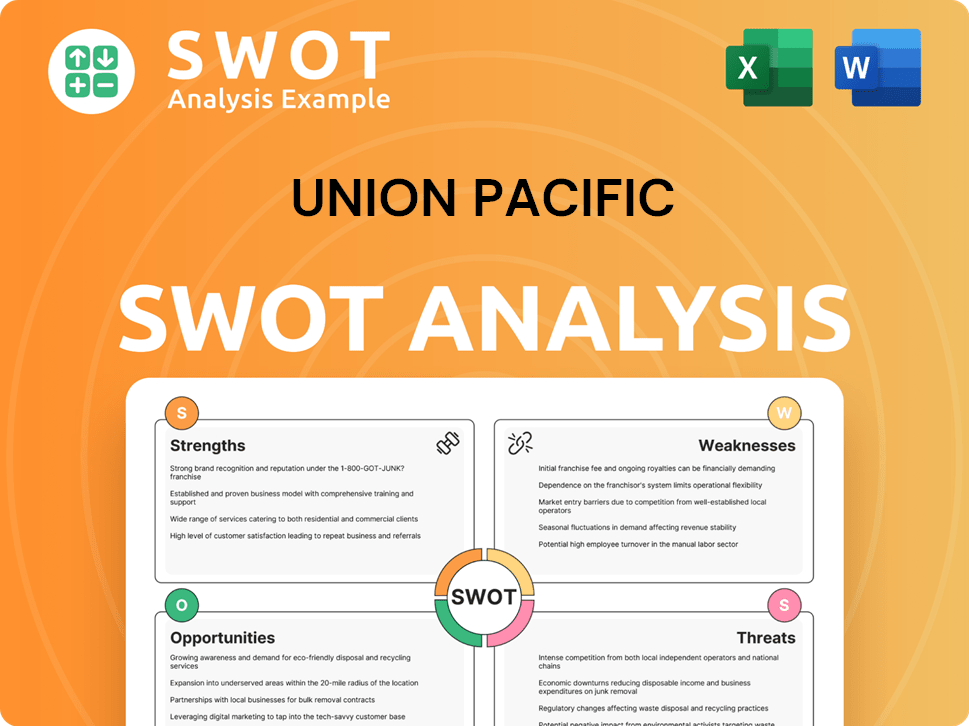
What Marketing Tactics Does Union Pacific Use?
The company employs a comprehensive approach to sales and marketing, blending digital and traditional methods to enhance brand awareness, generate leads, and boost sales. Their strategies are data-driven, leveraging market research to identify opportunities and understand market dynamics. This integrated approach helps the company maintain a strong market presence and adapt to changing customer needs.
Digital marketing is a key component of the company's strategy. They maintain an active presence on social media platforms and utilize search engine optimization (SEO) to improve online visibility. This digital focus is complemented by traditional media efforts, such as television commercials and print advertisements, to reach a wider audience and reinforce their brand messaging.
The company's marketing tactics are also heavily influenced by its pricing strategy, which is tied to specific freight metrics. This, combined with supply chain technology upgrades, allows the company to offer competitive rates and improve customer service. The company's sales and marketing efforts are designed to drive revenue and maintain a competitive edge in the transportation industry.
The company has a strong digital presence. They have a significant following on LinkedIn and Twitter, with approximately 92,000 followers and 45,000 followers respectively as of 2023.
The company's corporate website attracts around 1.2 million unique visitors annually. They also employ SEO strategies, with over 468,000 organic keywords and roughly 617,000 monthly website visits.
The company utilizes traditional media channels. They run TV commercials and print advertisements in newspapers to reach a broad audience.
In 2023, the company invested $22.3 million in safety-focused advertising campaigns. These campaigns reached approximately 45 million potential viewers across multiple media channels.
The company uses market research to identify new opportunities and understand its strengths and weaknesses. This data-driven approach helps refine their marketing strategies.
The company's pricing strategy is linked to specific freight metrics. In 2023, the average revenue per carload was $2,168. Transportation rates vary between $1.50 to $2.75 per mile based on commodity type and distance.
The company's strategy also involves improving supply chain visibility through technology upgrades. They are deploying and enhancing Application Program Interfaces (APIs) and are rolling out a 'Customer Vision' tool to improve shipment management. For a deeper understanding of the company's overall strategic direction, consider reading about the Growth Strategy of Union Pacific.
The company's marketing tactics are designed to enhance customer experience and drive revenue growth. These include a mix of digital and traditional methods, data-driven insights, and technological advancements.
- Utilizing digital platforms like LinkedIn and Twitter to engage with customers.
- Employing SEO strategies to increase online visibility and attract traffic.
- Running TV commercials and print ads to reach a broad audience.
- Investing in safety-focused advertising campaigns to promote safety.
- Leveraging market research to identify opportunities and understand the market.
- Implementing technology upgrades to improve supply chain visibility.
Union Pacific PESTLE Analysis
- Covers All 6 PESTLE Categories
- No Research Needed – Save Hours of Work
- Built by Experts, Trusted by Consultants
- Instant Download, Ready to Use
- 100% Editable, Fully Customizable
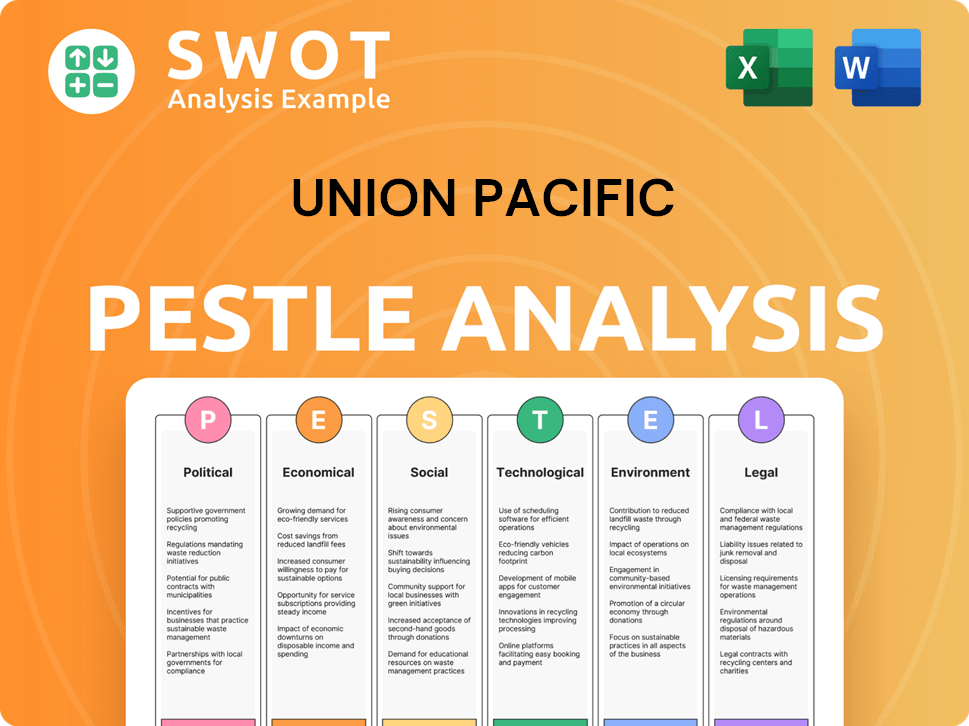
How Is Union Pacific Positioned in the Market?
Union Pacific's brand positioning centers on being North America's premier railroad franchise. They emphasize their extensive network, operational excellence, and commitment to sustainability. Their core message revolves around 'Building America,' connecting businesses and communities through safe, reliable, and efficient transportation solutions. This approach helps them stand out in the competitive landscape of the transportation industry.
The company's visual identity, incorporating its distinct logo and Copperplate Gothic typeface, aims to convey a sense of history combined with modernity. This strategic branding helps them appeal to their target audience, which primarily consists of businesses requiring transportation and logistics services. They highlight their role in the global supply chain, focusing on providing value through fuel-efficient and environmentally responsible transportation options.
Their commitment to sustainability is a key element of their brand. This is reflected in their recognition as a Sustainability Yearbook Member by S&P Global and their inclusion in America's Most Just Companies List by Just Capital. In 2024, they received the Clean Fuels Alliance's Industry Partnership Award, being the first Class 1 railroad to join the alliance. The year-end total utilization of biofuels for 2024 was 5.2%. This focus on sustainability is a crucial part of their brand positioning strategy.
Union Pacific emphasizes its commitment to providing safe and reliable transportation services. This focus is crucial for maintaining customer trust and ensuring the smooth operation of the supply chain. Their operational excellence is a key differentiator in the railroad marketing sector.
The company highlights its efficient transportation solutions, which are designed to meet the needs of businesses. This efficiency is a key component of their value proposition, attracting customers looking for cost-effective and timely shipping options. This is a core element of their railroad freight sales strategy.
Union Pacific actively promotes its sustainability efforts, including the use of biofuels and other environmentally friendly practices. These initiatives are central to their brand image and appeal to customers seeking eco-conscious transportation solutions. This is a key aspect of their transportation strategy.
The company focuses on building strong relationships with its customers. This customer-centric approach helps them understand and meet the specific needs of businesses, fostering loyalty and repeat business. This is critical for their UP sales and marketing success.
Union Pacific's brand positioning strategy is built on several key elements that work together to create a strong and recognizable brand. These elements are consistently communicated across all touchpoints to maintain a cohesive brand image.
- Extensive Network: Emphasizing the reach and coverage of their rail network.
- Operational Excellence: Highlighting their efficient and reliable service.
- Sustainability: Showcasing their commitment to environmental responsibility.
- Customer Focus: Building strong relationships with clients.
Union Pacific Business Model Canvas
- Complete 9-Block Business Model Canvas
- Effortlessly Communicate Your Business Strategy
- Investor-Ready BMC Format
- 100% Editable and Customizable
- Clear and Structured Layout
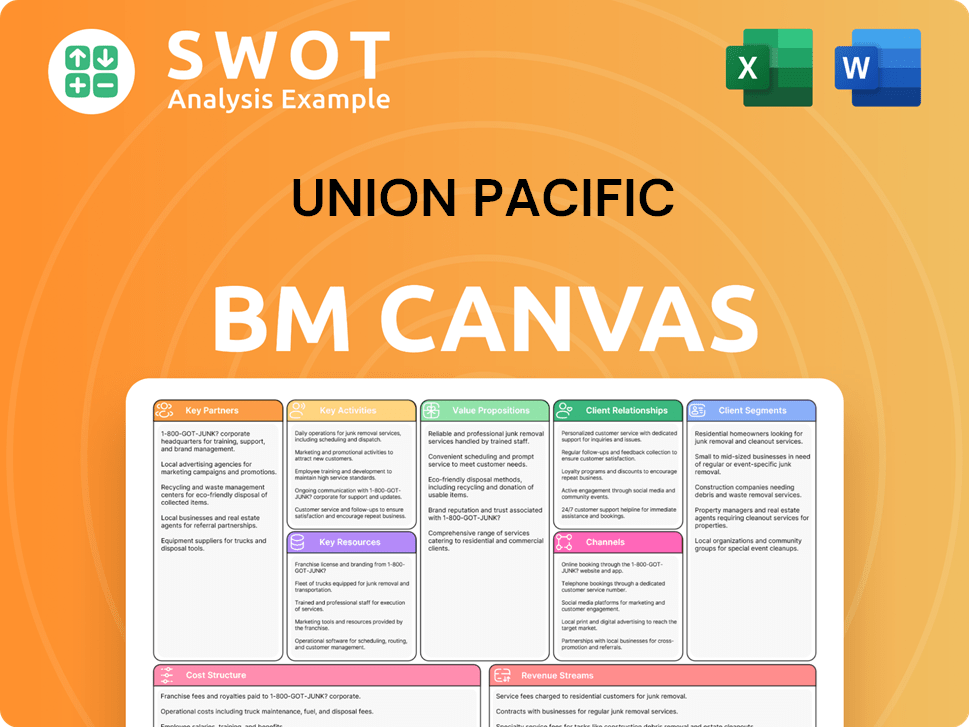
What Are Union Pacific’s Most Notable Campaigns?
The sales and marketing efforts of the company, focused on transportation strategy, include several key campaigns. The company's approach involves a blend of safety and sustainability initiatives, reflecting its commitment to both public well-being and environmental responsibility. These campaigns are designed to enhance brand perception, build customer relationships, and drive business growth within the rail freight sales sector.
A significant portion of the company's strategy is dedicated to promoting safety through various channels, including advertising and community outreach. This commitment is demonstrated through substantial investments in safety-focused advertising and partnerships aimed at educating the public. Furthermore, the company actively pursues sustainability goals, aiming to reduce its environmental impact through innovative technologies and collaborative efforts with customers and suppliers.
These campaigns are integral to the company's overall sales and marketing plan, contributing to its market share analysis and long-term growth. By focusing on safety and sustainability, the company aims to strengthen its position in the competitive transportation market and meet the evolving needs of its customers and stakeholders. Understanding the company's approach provides insights into its sales performance analysis and future sales growth strategies.
The company's national, multilingual rail safety campaign, a key element of its railroad marketing efforts, is a partnership with TPT NOW. This initiative aims to integrate rail safety into family discussions. In 2023, the company allocated $22.3 million to safety-focused advertising, generating approximately 45 million potential viewer impressions across various media platforms.
The company is committed to sustainability, targeting a 50.4% reduction in Scope 1, Scope 2, and Scope 3 greenhouse gas emissions by 2030, using a 2018 baseline. It deployed its first hybrid locomotive in 2024, with plans to modernize an additional 240 locomotives in 2025-2026. These modernizations are projected to reduce carbon emissions by approximately 350 tons per locomotive annually.
The company actively engages with communities, particularly focusing on safety education in areas like the Columbia River Basin. These efforts include public awareness campaigns and educational programs designed to inform and protect the public. This approach is part of the company's broader strategy to enhance its brand positioning strategy and build trust.
The company recognizes its customers and suppliers for their contributions to sustainability. In 2024, it honored 16 partners with its Sustainability Partner Award. These collaborations are crucial for achieving the company's sustainability objectives and promoting sustainable practices across its supply chain. This approach supports its customer relationship management efforts.
The 'Building America Report' serves as an annual report on the company's social, environmental, and economic sustainability progress. This report provides a comprehensive overview of the company's initiatives and achievements in these areas. For more detailed information on the company's sales and marketing efforts, you can refer to an article discussing the Union Pacific sales strategy.
- The report highlights the company's commitment to transparency and accountability.
- It showcases the company's efforts to reduce its environmental footprint and promote sustainable practices.
- The report also details the company's contributions to the communities it serves.
- It is a key component of the company's communication strategy with stakeholders.
Union Pacific Porter's Five Forces Analysis
- Covers All 5 Competitive Forces in Detail
- Structured for Consultants, Students, and Founders
- 100% Editable in Microsoft Word & Excel
- Instant Digital Download – Use Immediately
- Compatible with Mac & PC – Fully Unlocked
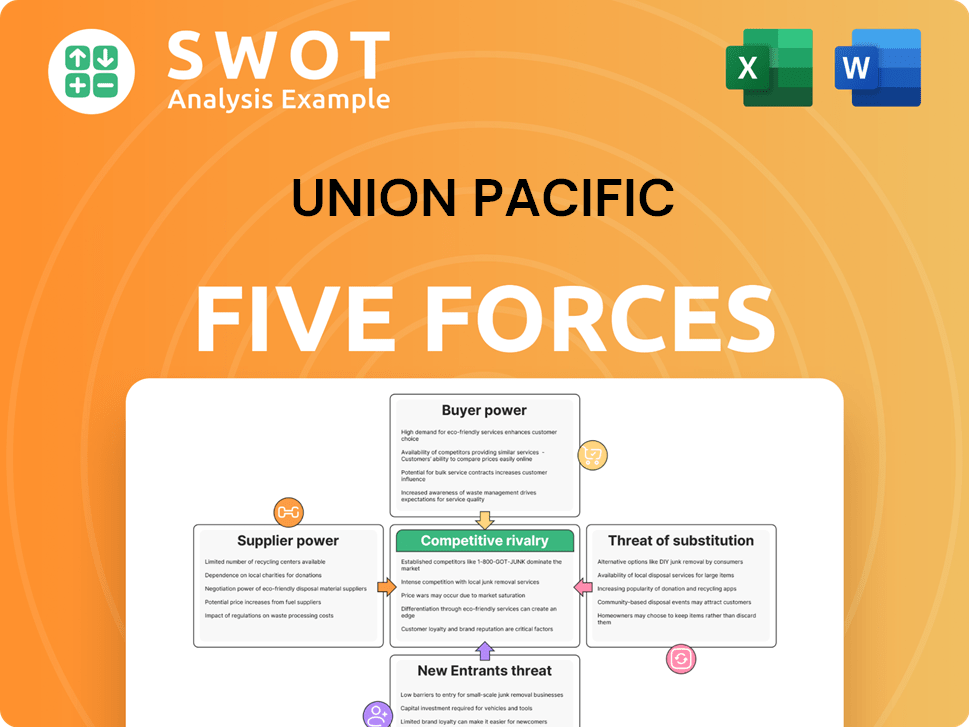
Related Blogs
- What are Mission Vision & Core Values of Union Pacific Company?
- What is Competitive Landscape of Union Pacific Company?
- What is Growth Strategy and Future Prospects of Union Pacific Company?
- How Does Union Pacific Company Work?
- What is Brief History of Union Pacific Company?
- Who Owns Union Pacific Company?
- What is Customer Demographics and Target Market of Union Pacific Company?
Disclaimer
All information, articles, and product details provided on this website are for general informational and educational purposes only. We do not claim any ownership over, nor do we intend to infringe upon, any trademarks, copyrights, logos, brand names, or other intellectual property mentioned or depicted on this site. Such intellectual property remains the property of its respective owners, and any references here are made solely for identification or informational purposes, without implying any affiliation, endorsement, or partnership.
We make no representations or warranties, express or implied, regarding the accuracy, completeness, or suitability of any content or products presented. Nothing on this website should be construed as legal, tax, investment, financial, medical, or other professional advice. In addition, no part of this site—including articles or product references—constitutes a solicitation, recommendation, endorsement, advertisement, or offer to buy or sell any securities, franchises, or other financial instruments, particularly in jurisdictions where such activity would be unlawful.
All content is of a general nature and may not address the specific circumstances of any individual or entity. It is not a substitute for professional advice or services. Any actions you take based on the information provided here are strictly at your own risk. You accept full responsibility for any decisions or outcomes arising from your use of this website and agree to release us from any liability in connection with your use of, or reliance upon, the content or products found herein.